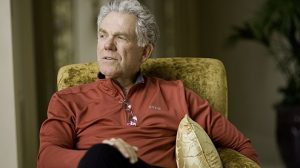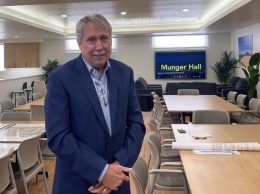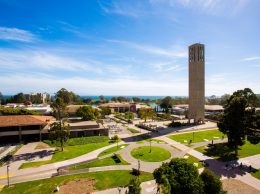$50M Henley gift puts UCSB in big leagues

Jeff Henley in a Business Times photo from 2005. The Oracle chairman recently awarded $50 million to UC Santa Barbara, the university’s largest philanthropic gift ever. (Business Times/Jeff Clark file photo)
Oracle Chairman Jeff Henley has called UC Santa Barbara the “best-kept secret in the world” — but with his recent $50 million donation to its Institute for Energy Efficiency and College of Engineering, the seaside school may not fly under the radar for much longer.
Henley and his wife, Judy, announced the gift, the largest the school has ever received and one of the largest on record in the region, at the Campaign for UC Santa Barbara’s kickoff event on May 12 at Bren Hall. Henley, who graduated from UCSB in 1966 and has lived in Santa Barbara for the past 12 years, is already one of the university’s biggest benefactors. He’s also the co-chair of the fundraising campaign and one of the founders of the school’s award-winning Institute for Energy Efficiency.
“Science and energy are fundamental,” Henley said at the kickoff event. “Since I helped found the IEE, I’ve gotten to know more and more about what we do. We need more labs if we’re going to continue to be the best. Coming from Silicon Valley [where software giant Oracle is based], I’ve seen that kids today need really good equipment and they need labs and space to study technology.”
UCSB Chancellor Henry Yang said Henley’s “extraordinary gift” is important to the school as a whole because it’s infused the fundraising campaign with excitement and momentum. And at a time when the state is cutting funding for its universities — 10 years ago, state funds made up 46 percent of UCSB’s budget; now it makes up 23 percent, Yang said — private giving plays a critical role in supporting the campus.
“As a society, higher education is the most important investment we can make in our future. Yet the University of California continues to face unprecedented reductions in state funding,” Yang told the Business Times in an email. “Philanthropic support has helped make it possible for UC Santa Barbara to stand today among the leading teaching and research institutions in this country and the world.”
Energy efficiency is a research priority for the campus, Yang said. “Our institute is leading the way to dramatically improved energy efficiency, as well as innovative and stronger sources of cost-effective, clean, sustainable energy.”
Since the institute opened its doors in 2008, it’s made its mark on the clean-energy community. It now has 50 research faculty and 150 postdoctoral students working on creating alternative energy technologies, with Director John Bowers and Executive Director David Auston at the helm. Three years ago, the U.S. Department of Energy gave the institute a $19 million grant to fund an Energy Frontier Research Center, one of 46 such centers around the country.
The institute can claim Transphorm, a Goleta-based company focused on creating energy-efficiency technology, as a success story. Umesh Mishra, a professor at the institute, founded the firm with his former student Primit Parikh. The company uses gallium-nitride semiconducting material to make energy-efficient electronics that reduce waste heat in devices. Last year, Transphorm attracted the attention of a few major investors when it secured $25 million in financing from a fund backed by George Soros and $38 million in a financing round led by Google Ventures.
One of the institute’s ultimate goals is to reduce the world’s dependence on fossil fuels. According to the institute’s brochure, fossil fuels are used for 85 percent of the world’s energy needs, but demand threatens to outpace supplies. To combat that fundamental problem, the institute is working on renewable energy, storage techniques and more efficient means of transmitting and converting electrical energy. To that end, one of the institute’s biggest projects is the development of an LED light with 20 times the efficiency of an incandescent bulb.
Another challenge for the faculty and students at the institute is to figure out a way to process the explosive growth of digital data. By 2025, there will be 1,000 times more data — including movie downloads, photo uploads and document storage — than there is today. The research center is developing a computer that can generate, transmit and store data 100 times faster than the ones that exist today.
The Henleys’ $50 million donation is divided into two pieces: $20 million is set to go to the College of Engineering for general use and $30 million will go toward the IEE — $5 million will be used to recruit and retain faculty and $25 million is earmarked for Henley Hall, the future base of operations for IEE. Henley Hall is the second construction project, after Henley Gate, that’s been named for the Oracle chairman and his wife.
The Campaign for UC Santa Barbara is an ongoing program that started in 2004 with a fundraising goal of $350 million. Since then, it has raised $710 million and the university has upped the ultimate goal to $1 billion.
“Jeff Henley is a pillar of technology. His donation will set the bar for other donors,” Rod Alferness, Dean of Engineering at UCSB, said at the May 12 campaign event. “This is an expression of a willingness to invest. It will have a huge impact on the college, and it’ll also be felt throughout the university. From the students’ perspective, it helps them see how good the energy institute really is.”
UCSB’s College of Engineering and the IEE have been racking up accolades over the last five years. The College of Engineering, which has 1,345 undergraduate students and 753 graduate students, is consistently ranked among the top engineering schools in the country and the world. In 2010, the National Research Council gave top rankings to UCSB in physics, electrical and computer engineering, computer science, mechanical engineering, chemistry and biochemistry, and the council ranked the school’s materials program first in the country. Times Higher Education named UCSB No. 1 in the world among all public universities for its impact on engineering research.
From Henley’s point of view, it’s the university’s trademark mix of academia and entertainment that make it worthy of the biggest philanthropic gift he and his wife have ever made. “I went here in the 1960s, and one of the great things about the school is that it makes no apologies for being fun. I was a serious student, but I went to the beach and had a lot of fun. We made this donation because we finally found something we thought was worth this investment,” Henley said at the event.
Henley serves as chairman of the board at Oracle, a hardware and software engineering company based in Redwood Shores with a market capitalization of about $133 billion. He was Oracle’s chief financial officer from 1991 to 2004.









